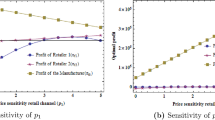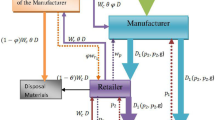Abstract
To reduce pollution and more uses of natural resources, the concept of recycle of used products and apply to everyday life is urgent for maintaining a sustainable life. In this context, an important positive strategy is to buy products when one customer does have to throw an item away. Based on this concept, the demand function of end customers is assumed as sales prices and recycling factors sensitive. In this paper, we develop cooperative as well as non-cooperative model of a closed-loop supply chain that consists of a manufacturer and duopolies retailers and compare the model with cournot and collusion games. Under Stackelberg setting among the manufacturer and the retailers, the duopolies retailers compete with each other under cournot and collusion games. A numerical example is given to justify the proposed model.
Similar content being viewed by others
References
Cachon GP, Lariviere MA (2005) Supply chain coordination with revenue-sharing contracts: strengths and limitations. Manag Sci 51(1):30–44
Cardenas-Barron LE (2007) Optimizing inventory decisions in a multi stage multi customer supply chain: a note. Transp Res E 43(5):647–654
Cardenas-Barron LE, Porter JD (2013) Supply chain models for an assembly system with preprocessing of raw materials: a simple and better algorithm. Appl Math Model 37 (14):7883–7887
Cardenas-Barron LE, Sarkar B, Trevino-Garza G (2013) An improved solution to the replenishment policy for the EMQ model with rework and multiple shipments. Appl Math Model 37(7):5549–5554
Cardenas-Barron LE, Teng JT, Trevino-Garza G, Wee HM, Lou KR (2012) An improved algorithm and solution on an integrated production-inventory model in a three-layer supply chain. Int J Prod Econ 136:384–388
Chen TH, Chen JM (2005) Optimizing supply chain collaboration based on joint replenishment and channel coordination. Transp Res E 41(4):261–285
Choi TM, Sethi S (2010) Innovative quick response programs: a review. Int J Prod Econ 114:456–475
Ding D, Chen J (2008) Coordinating a three level supply chain with flexible return policies. Omega 36(5):865–876
Giannoccaro I, Pontrandolfo P (2004) Supply chain coordination by revenue sharing contracts. Int J Prod Econ 89(2):131–139
Grubbstrom RW, Wang Z (2003) A stochastic model of multi-level/multi-stage capacity constrained production-inventory systems. Int J Prod Econ 81-82(1):483– 494
Gurnani H (2001) A study of quantity discount pricing models with different ordering structures: order coordination, order consolidation, and multi-tier ordering hierarchy. Int J Prod Econ 72(3):203–225
Hill RM, Omar M (2006) Another look at the single-vendor single-buyer integrated production inventory problem. Int J Prod Res 44(4):791–800
Hoque MA, Goyal SK (2000) An optimal policy for a single-vendor single-buyer integrated production-inventory system with capacity constraint of the transport equipment. Int J Prod Econ 65(3):305–315
Huq F, Cutright K, Jones V, Hensler DA (2006) Simulation study of a two-level warehouse inventory replenishment system. Int J Phys Distrib Logist Manag 36(1):51–65
Ingene CA, Parry ME (1995) Channel cooperation when retailers compete . Mark Sci 14(4):360–377
Kim T, Hong Y, Lee J (2006) Joint economic production allocation and ordering policies in a supply chain consisting of multiple plants and a single retailer. Int J Prod Res 43 (17):3619–3632
Kim B, Oh H (2005) The impact of decision making sharing between supplier and manufacturer on their collaboration performance. Supply Chain Management: An International Journal 10(3–4):223–236
Larsen S T (2000) European logistics beyond. Int J Phys Distrib Logist Manag 30(6):377–387
Li J, Liu L (2006) Supply chain coordination with quantity discount policy. Int J Prod Econ 101(1):89–98
Li SX, Huang Z, Ashley A (1996) Improving buyer-seller system cooperation through inventory control. Int J Prod Econ 43(1):37–46
Lu L (1995) A one-vendor multi-buyer integrated model. Eur J Oper Res 81(2):312–323
Modak NM, Panda S, Sana SS (2015a) Three-echelon supply chain coordination considering duopolistic retailers with perfect quality products. Int J Prod Econ Article in press . doi:10.1016/j.ijpe.2015.05.021
Modak NM, Panda S, Sana SS (2015b) Pricing policy and coordination for a distribution channel with manufacturer suggested retail price. Int J Syst Sci Operations Logistics. Article in press. doi:10.1080/23302674.2015.1053828
Modak NM, Panda S, Sana SS, Basu M (2014) Corporate social responsibility, coordination and profit distribution in a dual-channel supply chain. Pacific Science Review 16(4):235– 249
Moses M, Seshadri S (2000) Policy mechanisms for supply chain coordination. IIE Trans 32(3):254–262
Munson CL, Rosenblatt MJ (2001) Coordinating a three-level supply chain with quantity discounts. IIE Trans 33(5):371– 384
Panda S (2014) Coordination of a socially responsible supply chain using revenue sharing contract. Transp Res E 67:92–104
Panda S (2014) Coordination and profit sharing in a supply chain through compensation on disposal cost. International Journal of Operational Research. forthcoming
Panda S, Modak NM, Basu M (2014) Disposal cost sharing and bargaining for coordination and profit division in a three-echelon supply chain International. J Manag Sci Eng Manag 9 (4):276–785
Panda S, Modak NM, Basu M, Goyal SK, Channel coordination and profit distribution in a social responsible three-layer supply chain (2015a). Int J Prod Econ 168:224–233
Panda S, Modak NM, Sana SS, Basu M (2015b) Pricing and replenishment policies in dual-channel supply chain under continuous unit cost decrease. Appl Math Comput 256:913–929
Pasternack B (1985) Optimal pricing and returns policies for perishable commodities. Mark Sci 4(2):166–176
Shah NH, Soni HN, Patel AK (2013) Optimizing inventory and marketing policy for non-instantaneous deteriorating items with generalized type deterioration and holding cost rates. Omega 41 (2):421–430
Saha S, Panda S, Modak NM, Basu M (2015) Mail-in-rebate coupled with revenue sharing and downward direct discount for supply chain coordination. Int J Oper Res 23(4):451–476
Savaskan RC, Bhattacharya S, Van Wassenhove LN (2004) Closed-loop supply chain models with product remanufacturing. Manage Sci 50(2):239–252
Simatupang TM, Wright AC, Sridharan R (2002) The knowledge of coordination for supply chain integration. Bus Process Management J 8(3):289–308
Taylor TA (2002) Coordination under channel rebates with sales effort effect. Manag Sci 48(8):992–1007
Vander Rhee B, Vander Veen JAA, Venugopal V, Nall VN (2010) A new revenue sharing mechanism for coordinating multi-echelon supply chains. Oper Res Lett 38(4):296–301
Wang S, Wang J, Zhou Y (2012) Channel coordination with different competitive duopolistic retail behaviour and non-linear demand function . Int J Manag Sci Eng Manag 7(2):119–127
Wei Y, Choi TM (2010) Mean-variance analysis of supply chains under wholesale pricing and profit sharing schemes. Eur J Oper Res 204(2):255–262
Wong WK, Qi J, Leung SYS (2009) Coordinating supply chains with sales rebate contracts and vendor-managed inventory. Int J Prod Econ 121(1):151–161
Wu K, Ouyang L (2003) An integrated single-vendor single-buyer inventory system with shortage derived algebraically. Prod Plann Control 14(6):555–561
Xiao T, Qi X (2008) Price competition, cost and demand disruptions and coordination of a supply chain with one manufacturer and two competing retailers. Omega 741–753:36
Yao MJ, Chiou CC (2004) On a replenishment coordination model in an integrated supply chain with one vendor and multiple buyers. Eur J Oper Res 159(2):406–419
Zou X, Pokharel S, Piplani R (2004) Channel coordination in an assembly system facing uncertain demand with synchronized processing time and delivery quantity. Int J Prod Res 42(22):4673–4689
Yang S, Zhou Y (2006) Two-echelon supply chain models: considering duopolistic retailers’ different competitive behaviors. Int J Production and Economics 104–116:103
Author information
Authors and Affiliations
Corresponding author
Rights and permissions
About this article
Cite this article
Modak, N.M., Panda, S. & Sana, S.S. Two-echelon supply chain coordination among manufacturer and duopolies retailers with recycling facility. Int J Adv Manuf Technol 87, 1531–1546 (2016). https://doi.org/10.1007/s00170-015-8094-y
Received:
Accepted:
Published:
Issue Date:
DOI: https://doi.org/10.1007/s00170-015-8094-y




